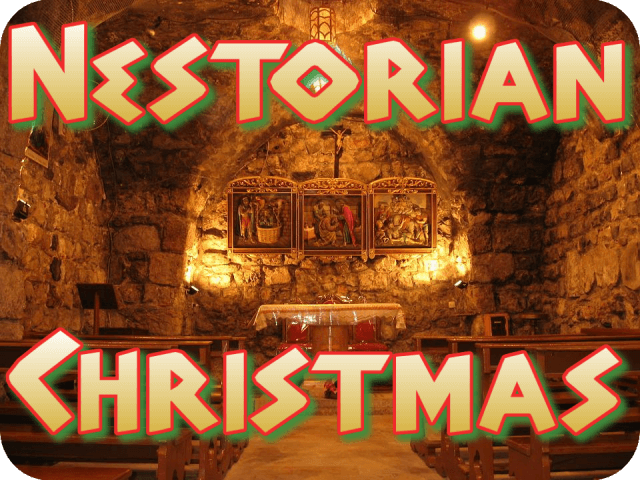Some links may be affiliate links. We get money if you buy something or take an action after clicking one of these links on our site.
Christmas All The Time is a participant in the Amazon Services LLC Associates Program, an affiliate advertising program designed to provide a means for sites to earn advertising fees by advertising and linking to Amazon.com. As an Amazon Associate, I earn from qualifying purchases.

Nestorian Christmas
Excuse me. Who? The Church of the East predates its informal namesake by a few decades. This month, we’ll take a closer look at this little-known branch of Christianity.
Early Eastern Church
If, then, you are looking for the way by which you should go, take Christ, because He Himself is the way. ~Thomas Aquinas
Following in the footsteps of the Apostle Thomas, a variety of Christian traditions and denominations sprung up throughout the Levant.
The Church of the East was formally established in 410 to serve the populace of the Sassanian Empire.
This empire covered an area that encompasses countries we know today as Iran, Iraq, Kurdistan, Armenia, Kuwait, Bahrain, Qatar, the UAE and parts of Turkey, Syria and Oman.
The leader of the Church of the East, also known as the East Syriac Church, held the title of “Catholicose of the East“. His diocesan seat was located in Seleucia–Ctesiphon. These ancient twin cities were located about 20 miles southeast of Baghdad, Iraq.
In 424, they declared themselves independent of the Roman Catholic Church and severed all ties in 431 due to the controversy of the theological positions stated by Archbishop Nestorius during the First Council of Ephesus.
Christmas Controversy, Yet Another Family Feud
Nestorius: Archbishop of Constantinople
One of the many issues that drove a wedge between the early Christian communities was a basic disagreement over the divine nature of Jesus himself. It even drove Saint Nicholas to punch another theologian at the Council of Nicea in 325.
Nestorius, a theologian and minister trained in Antioch, believed that the divinity of Jesus was separate from his humanity. This eastern belief ran counter to the Alexandrian school of thought which held that Jesus was fully human and divine.
When Nestorius was appointed as Archbishop of Constantinople, the Alexandrians were quick to act against him and his “two natures” teachings.
Then, as now, politics were divisive and destructive to the overall community.
Then, as now, the thought leaders considered these philosophical divisions to be of immense importance.
Then, as now, these differences meant virtually nothing to the average parishioner and seem to have been grossly self-serving.
Ultimately, Nestorius put his foot in it on Christmas Day in 428 when he began a series of sermons expressing that Mary is not the Mother of God despite the Trinitarian beliefs more common in western churches.
Ultimately, the decision was addressed at the First Council of Ephesus in 431, costing Nestorius his seat as Archbishop. He was sent to a monastery near Antioch and exiled to a monastery in the Libyan Desert in 435. To keep him off balance and even farther from polite society, he was reassigned to a monastery in Panopolis in 436. He remained at this distant, poorly-protected frontier monastery until his death in 451.
Although he was apparently defeated, shamed and exiled until his death, the Church of the East included Nestorius among its host of saints.
The Rest Of The Story
I prayed for twenty years but received no answer until I prayed with my legs. ~Frederick Douglass
|
|
|
The outcome of the First Council of Ephesus was more profound than the demotion and exile of Nestorius. The Oriental Orthodox Churches rejected the dictates of the Council in 431, facing eastward and pressing on with their mission in the Sassanian Empire and beyond.
With the expanse of Islam in the 7th Century, the Church of the East spread throughout Central and Eastern Asia, even interacting with the Tang Dynasty in 7th Century China and with the court of Ghengis Khan in the 13th Century.
This branch of Christianity actually covered more of the Earth’s surface than any other denomination in the Early Middle Ages, spreading eastward from Persia to India, northward through the Caucasus and the Steppes into Central Asia.
An 7th Century stele was discovered in Xi’an, stating that Nestorian Christians were welcome and highly regarded in China at that time.
Ancient Chinese Historian Describes The First Christians (635 AD) // The Nestorian Stele
Unfortunately, nothing lasts forever. The division of the Mongolian Empire and changes in Islamic communities in the wake of the Crusades led to a widespread persecution and elimination of these Asian churches from the 14th Century onward. Only a few scattered pockets of this once widespread church family remain.
Even though the spiritual descendents of Saint Thomas and Archbishop Nestorius are few and scattered, it’s still interesting to think that Christmas was celebrated across the face of Asia in ages past when Christianity was just beginning to take hold in Western Europe and shape our culture.
The early years of Christianity were tumultuous, not only because of Roman persecution but also due to internal strife. The nuances of doctrine, ritual and even politics led to irreparable schisms.
Without the instantaneous, worldwide communication that we enjoy today, the different branches of the church were free to spread across the surface of the world and share the Good News with each culture they encountered in their own way.